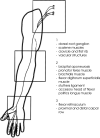Carpal tunnel syndrome conservative treatment: a literature review
- PMID: 37082094
- PMCID: PMC9881572
- DOI: 10.5114/ppn.2022.116880
Carpal tunnel syndrome conservative treatment: a literature review
Abstract
Purpose: Carpal tunnel syndrome (CTS) is the most common compression neuropathy, which is associated with a significant psy- chosocial and economic burden. In this paper, the literature on the current knowledge about the physiology and pathology of peri- pheral nerves during the course of CTS is reviewed, with a focus on currently used treatment options and the rationale for their use. Epidemiology, risk factors, etiology, clinical features and conservative treatment have been searched for, with all full-text, English language articles being included in the study. This paper aims to present the recent findings on CTS treatment while also suggesting a direction for further clinical trials.
Views: The search in PubMed and Google Scholar Databases revealed 229 articles of which 71 met the research criteria. The evi- dence regarding standard treatment methods of conservative CTS treatment is presented. CTS is a relatively common condition, which affects women more often than men. It is a multifactorial disease, and its clinical presentation mostly consists of symptoms distal to the entrapment site, including numbness, tingling, weakness and pain. Electrodiagnostic studies are considered to be the gold standard in CTS diagnosis. The conservative treatment methods reviewed are acupuncture, extracorporeal shock wave the- rapy, hydrodissection, kinesiotaping, corticosteroid injection, low level laser therapy, splints, platelet-rich plasma injection, manual therapy, ultrasound and phonophoresis.
Conclusions: Based on the current body of knowledge, we conclude that the conservative CTS treatment is very safe, but the effec- tiveness of reviewed methods differs. The first promising results presented by various studies motivate the need for further research on novel treatment methods.
Keywords: carpal tunnel syndrome; conservative treatment; peripheral nervous system; physiotherapy.
Copyright © 2022 Institute of Psychiatry and Neurology.
Conflict of interest statement
Absent.
Figures
References
-
- Atroshi I, Englund M, Turkiewicz A, Tägil M, Petersson IF. Incidence of physician-diagnosed carpal tunnel syndrome in the general population. Arch Intern Med 2011; 171: 943-944. - PubMed
-
- Atroshi I, Gummesson C, Johnsson R, Ornstein E, Ranstam J, Rosén I. Prevalence of carpal tunnel syndrome in a general population. J Am Med Assoc 1999; 282: 153-158. - PubMed
-
- Pelosi L, Arányi Z, Beekman R, Bland J, Coraci D, Hobson-Webb LD, et al. . Expert consensus on the combined investigation of carpal tunnel syndrome with electrodiagnostic tests and neuromuscular ultrasound. Clin Neurophysiol 2022; 135: 107-116. - PubMed
-
- Ellis R, Blyth R, Arnold N, Miner-Williams W. Is there a relationship between impaired median nerve excursion and carpal tunnel syndrome? A systematic review. J Hand Ther 2017; 30: 3-12. - PubMed
Publication types
LinkOut - more resources
Full Text Sources
Medical
Research Materials
Miscellaneous

